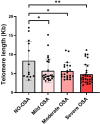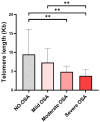Telomere shortening in middle-aged and elderly individuals with varying severities of obstructive sleep apnea
- PMID: 40825835
- PMCID: PMC12361441
- DOI: 10.1038/s41598-025-15895-9
Telomere shortening in middle-aged and elderly individuals with varying severities of obstructive sleep apnea
Abstract
Obstructive sleep apnea (OSA) is characterized by repeated episodes of upper airway obstruction during sleep and leads to oxidative stress, systemic inflammation, and potentially accelerated telomere shortening. Studies comparing telomere length (TL) in individuals with and without OSA have obtained inconsistent results. This study compared TL across individuals without and with OSA of varying severity. We recruited 103 participants from a sleep clinic, all of whom underwent in-laboratory polysomnography and TL measurement. To assess TL, quantitative PCR was conducted for genomic DNA extracted from peripheral blood samples. Four participants were excluded because of sleep durations of < 4 h during polysomnography. The final analysis included 99 individuals (46 men and 53 women). Among these individuals, 13 did not have OSA; 28, 24, and 34 had mild OSA, moderate OSA, and severe OSA, respectively. Telomeres were significantly longer in individuals without OSA than in individuals with mild, moderate, and severe OSA (8.4 ± 5.1 kb, 5.7 ± 3.1 kb, 5.7 ± 2.2 kb, and 4.8 ± 2.6 kb, respectively; P = 0.009). Among individuals aged < 50 years, no significant difference was observed in TL between the non-OSA and OSA groups. However, among individuals aged ≥ 50 years, individuals without OSA had significantly longer telomeres than did individuals with moderate to severe OSA. Our findings indicate that telomere shortening was significantly more pronounced in patients with increasing OSA severity than in individuals without OSA. Nocturnal hypoxia-induced inflammation in patients with OSA may contribute to telomere shortening.
Keywords: Obstructive sleep apnea; Quantitative PCR; Telomere.
© 2025. The Author(s).
Conflict of interest statement
Declarations. Ethics approval and consent to participate: This study obtained approval from the Institutional Review Board of Tsaotun Psychiatric Center, Ministry of Health and Welfare, Taiwan. All participants provided their informed consent. Competing interests: The authors declare no competing interests.
Figures
References
-
- Dopheide, J. A. Insomnia overview: epidemiology, pathophysiology, diagnosis and monitoring, and nonpharmacologic therapy. Am. J. Manag Care. 26(4 Suppl), S76–s84 (2020). - PubMed
MeSH terms
LinkOut - more resources
Full Text Sources




